CHAMBERLAIN PROCLAIMS “PEACE FOR OUR TIME”
London, England · October 1, 1938
The storm clouds of war in Europe seemed to have parted on this date in 1938 in London, one day after Prime Minister Neville Chamberlain had returned from his triumph in Munich. Three visits to Germany had been required to part the clouds: the first to Berchtesgaden in the German Alps on September 15, 1938, the next to Bad Godesberg near Bonn on September 22, and the last to Munich on September 29–30. It was the last visit that produced the document (drafted by Hermann Goering) agreed to by the European Big Four: German dictator Adolf Hitler, Italian strongman Benito Mussolini, Chamberlain, and Chamberlain’s democratic partner, French prime minister Édouard Daladier.
Following on the annexation (Anschluss) of Austria (now christened Ostmark) into the Third Reich in March 1938, the Munich Agreement of September 29, 1938, legitimized Hitler’s land grab of the Sudetenland, the German-speaking, westernmost part of Czechoslovakia that had once been a part of the Austro-Hungarian Empire before it dissolved into new multiethnic states in the aftermath of World War I. Czech President Edvard Beneš was not a party to the any of the Big Four discussions but submitted under heavy Anglo-French pressure, promising to abide by the agreement. Czech Sudetenland was incorporated into the Reich on October 10, 1938, and the grateful German population became one of the most pro-Nazi regions of the Third Reich.
Hitler callously signed a second document at Munich, pledging no further territorial ambitions. “In spite of the hardness and ruthlessness I thought I saw on his face,” Chamberlain said of his meetings with Hitler, “I got the impression that here was a man who could be relied upon when he had given his word.” It was Hitler’s written pledge of no other territorial interests in Czechoslovakia that Chamberlain famously waved to crowds at the West London airport, declaring that he had secured “peace with honor,” which he believed was “peace for our time.” These words turned out to be Chamberlain’s political epitaph. They remain the most indelible symbol of irony and the futility of appeasing dictators and bullies that exist in the history of World War II. But for the moment, both Britain and France expressed relief that Hitler’s saber-rattling had not led to war.
[amazon_carousel widget_type=”ASINList” width=”600″ height=”200″ title=”Recommended Reading” market_place=”US” shuffle_products=”False” show_border=”False” asin=”1439132348,071904832X,1597970395,0393322521,0691070741,0754656152,0333417135,1585671304,0141441720,1848853777″ /]
Surrender at Munich: The Munich Conference, September 29–30, 1938
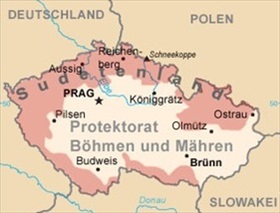 | 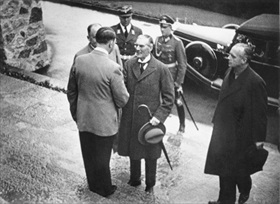 |
Left: The German-speaking regions of Czechoslovakia (highlighted in burgundy within an outline map of the current Czech Republic) were popularly referred to in the interwar years as Sudetenland. The Czech part of Czechoslovakia was subsequently invaded by Nazi Germany in March 1939, with a portion being annexed and the remainder turned into the Protectorate of Bohemia and Moravia (Protektorat Boehmen und Maehren) shown in pink on this map. The Slovak part declared its independence from Czechoslovakia, becoming the Slovak Republic, a satellite state and ally of Nazi Germany during World War II.
![]()
Right: On September 15, 1938, Chamberlain met with Hitler at his Alpine retreat, the Berghof near Berchtesgaden, and agreed to the cession of the Sudetenland; three days later French Prime Minister Édouard Daladier agreed to the same. A week later Chamberlain met Hitler in Bad Godesberg to confirm the oral agreements. Hitler now demanded not only the annexation of the Sudetenland but the immediate military occupation of the region, giving the Czechoslovak army no time to adapt their defense measures to the new borders.
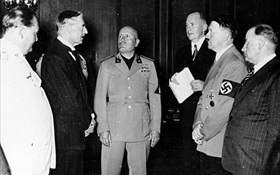 | 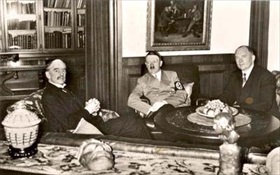 |
Left: Hermann Goering (left in photo), who authored the proposal Benito Mussolini (center) pitched to Chamberlain and Daladier (extreme right) for a Munich conference to end the Czechoslovakian “problem” (Chamberlain’s words), listens to the British prime minister speak through a German Foreign Office interpreter, Paul-Otto Schmidt (holding folder).
![]()
Right: Seated in comfortable chairs in Munich’s Fuehrerbau (today’s Hochschule fuer Musik und Theater Muenchen), Chamberlain, Hitler, and Daladier pose awkwardly for a photograph during the Munich Conference, September 29–30, 1938.
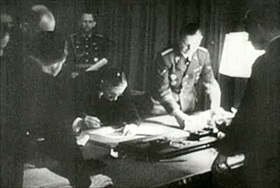 | 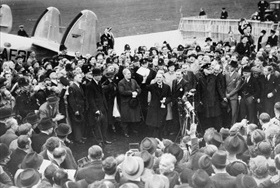 |
Left: Aided by the light of a table lamp, Chamberlain affixes his signature to the Munich Agreement at about 1:30 a.m. on September 30, 1938. Standing opposite Chamberlain on the other side of the desk is German Foreign Minister von Ribbentrop.
![]()
Right: On his triumphal return on September 30, 1938, to West London’s Heston Aerodrome, Chamberlain held aloft the Anglo-German Declaration signed by Hitler and himself, the ill-famed “Peace for our time” document, which was separate from the Munich Agreement. Likewise, the surprisingly tumultuous reception French premier Daladier received on his return from Munich suggested that most Frenchmen (the clairvoyant Daladier called his reception committee “les cons,” “the fools”) were as happy as the English were with the results of the Munich Conference. U.S. President Franklin D. Roosevelt, upon learning of the Munich Agreement and the avoidance of a new world war, sent a two-word telegram to Chamberlain: “Good man.”
Chamberlain’s Homecoming from Munich Conference: “Peace for Our Time”
![]()

 History buffs, there is good news! The Daily Chronicles of World War II is now available as an ebook for $4.99 on Amazon.com. Containing a year’s worth of dated entries from this website, the ebook brings the story of this tumultuous era to life in a compelling, authoritative, and succinct manner. Featuring inventive navigation aids, the ebook enables readers to instantly move forward or backward by month and date to different dated entries. Simple and elegant! Click
History buffs, there is good news! The Daily Chronicles of World War II is now available as an ebook for $4.99 on Amazon.com. Containing a year’s worth of dated entries from this website, the ebook brings the story of this tumultuous era to life in a compelling, authoritative, and succinct manner. Featuring inventive navigation aids, the ebook enables readers to instantly move forward or backward by month and date to different dated entries. Simple and elegant! Click 











